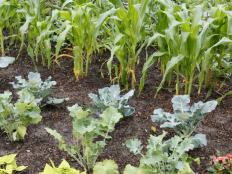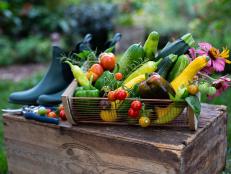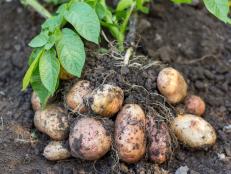Vegetable Garden Design Ideas

Irina Fischer / Shutterstock.com
Get ready for one of gardening’s grandest adventures: growing your own food. With modern vegetable varieties, you can find vegetable garden designs that suit any possible growing space, from sprawling small acreage, to rooftop community garden. You’ll get the most harvest for your efforts if you take a few minutes to cobble some vegetable garden plans before heading out to buy seeds or transplants.
Everybody’s growing vegetables these days, intent on saving money, living better and eating well. You can get in on the homegrown harvest no matter what size garden you have—or don’t have. There’s a vegetable garden design to suit every growing environment. If raising your own food brings to mind images of victory gardens with long rows of vegetables marching in military precision, it’s time to discover 21st century vegetable garden design ideas.
Today’s vegetable garden plans commingle plants—petunias and peppers, lettuce and pansies, eggplants and peonies. You can effectively tend a harvest for fresh eating just by tucking vegetables into existing planting areas. But if you’re growing to stock a pantry for winter feasting, you’ll need a vegetable garden design with a larger footprint to accommodate greater numbers of plants.
Small vegetable garden designs often practice succession planting—where plants are removed as soon as the harvest is complete so something else can be planted. After lettuces bolt, you pull plants and replant the spot with a crop that matures quickly, such as green beans or quick-ripening bush tomato varieties. Square-foot gardening methods combine tight plant spacing with succession planting to ensure that every single inch of a small vegetable garden design is utilized intensively.
Raised vegetable garden designs provide a terrific option when you’re dealing with difficult native soil, nearby walnut trees or want a formal-looking food production space. You can purchased raised bed kits or simply build your own. It doesn’t take heavy-duty DIY skills to screw lumber together.
If you want to use raised beds, ponder a long-range plan for your vegetable growing area. Do you intend to expand it one day? If so, take a few moments at the start to draw out the final design, so you can add beds in an orderly fashion as funds and time permits. When you plan more than one raised bed, consider what surface will be underfoot between them. If it’s grass, make sure you leave a wide-enough space between beds to fit your mower.
For the look of a potager, a French garden design, install gravel between beds. Gravel helps reduce weeds and pests, retains heat, which many veggies crave, and provides a happy crunch underfoot. Gravel also keeps leafy vegetables cleaner, because soil isn’t exposed and splashing onto leaves.
Other key things to consider in your vegetable garden design are sunlight, soil and water. Vegetables yield best when they receive full sun and have rich, well-drained soil. They also demand ample water. Locate your garden near a water source to make irrigation less of a chore, especially if you’re doing it by hand.
No matter what type of vegetable garden plan you choose, it’s vital to practice crop rotation—changing which veggies you grow in which spots—from year to year. This technique helps to reduce pest and disease outbreaks, which ultimately means more harvest for your dinner table.














































